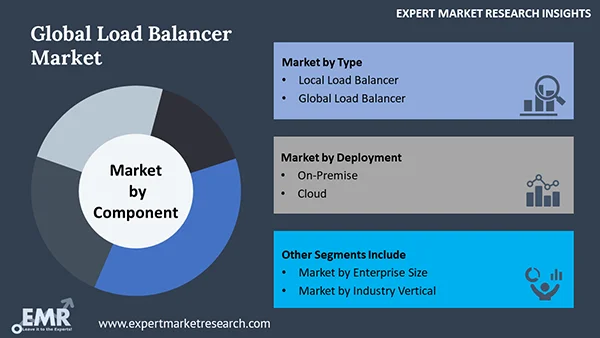
Consumer Insights
Uncover trends and behaviors shaping consumer choices today
Procurement Insights
Optimize your sourcing strategy with key market data
Industry Stats
Stay ahead with the latest trends and market analysis.
The global load balancer market attained a value of about USD 6.22 Billion in 2025. The market is further expected to grow in the forecast period of 2026-2035 at a CAGR of 12.90% to reach a value of around USD 20.93 Billion by 2035.
Base Year
Historical Period
Forecast Period
Compound Annual Growth Rate
12.9%
Value in USD Billion
2026-2035
*this image is indicative*
Load balancers have revolutionised the way the telecommunications business used to operate. Proliferating developments such as internet use, Wi-Fi, and work from home have driven the telecommunications industry to implement load balancing solutions. As a result of these trends, the demand for load balancing devices has increased, consequently aiding the market growth. Also, due to the sturdiness of a load balancer, it has been extended further for distribution and cloud expansion with the help of cloud technology.

Read more about this report - REQUEST FREE SAMPLE COPY IN PDF
The rise in connected device adoption has boosted demand for load balancers, which is projected to drive the market. The expansion is aided by multi-access edge computing and widespread sensor use among various sectors. Furthermore, advanced technologies necessitate high-performance systems capable of handling massive workloads. The introduction of software network technologies and advancements in platform-based applications has aided the rise of the load balancer industry.

Read more about this report - REQUEST FREE SAMPLE COPY IN PDF
Load balancing is a physical device that distributes network traffic efficiently among multiple servers in a server pool or server farm. Every load balancer connects backend servers and client devices, then delivers and distributes requests to any available server that can handle them. Directing queries to online servers ensures fast connection due to high availability.
The major components of load balancer are:
The market can be broadly categorised on the basis of its type into:
The market, on the basis of deployment, can be fragmented into:
The market on basis of enterprise size can be divided into:
The major industry vertical of load balancer industry are:
The EMR report looks into the regional markets of load balancer like:
Increased organisational understanding of the cloud's benefits and the ease of migrating from traditional systems to the cloud make technology more easy, scalable, and accessible. Cloud solutions are widely used by businesses to host and run mission-critical data and applications. The fundamental goal of any organisation is to maintain availability and efficiency, and load-balancing is one of the simplest and most cost-effective ways to achieve this goal. As a result, the market for load balancers is expected to be driven by the use of cloud-based solutions and Internet Relay Chat systems.
In terms of cloud usage, the IT and telecommunications industries are witnessing the most rapid growth. Many firms are focusing on quickly responding to client or user requests as interconnection is growing. The usage of cloud computing, particularly for storage and applications, has increased as the number of internet users has grown. As a result, the requirement for efficient workload balance on multi-load servers has grown. The rise in cloud computing facilities is a crucial aspect that is significantly contributing to the industry growth of load balancer.
The report presents a detailed analysis of the following key players in the global load balancer market, looking into their capacity, market shares, and latest developments like capacity expansions, plant turnarounds, and mergers and acquisitions:
The comprehensive report looks into the macro and micro aspects of the industry. The EMR report gives an in-depth insight into the market by providing a SWOT analysis as well as an analysis of Porter’s Five Forces model.




*While we strive to always give you current and accurate information, the numbers depicted on the website are indicative and may differ from the actual numbers in the main report. At Expert Market Research, we aim to bring you the latest insights and trends in the market. Using our analyses and forecasts, stakeholders can understand the market dynamics, navigate challenges, and capitalize on opportunities to make data-driven strategic decisions.*
Get in touch with us for a customized solution tailored to your unique requirements and save upto 35%!
In 2025, the global load balancer market attained a value of nearly USD 6.22 Billion.
The market is projected to grow at a CAGR of 12.90% between 2026 and 2035.
The market is estimated to witness a healthy growth in the forecast period of 2026-2035 to reach a value of about USD 20.93 Billion by 2035.
The major market drivers include rising usage of cloud-based technologies, expansion in artificial intelligence applications, and rising investments by various governments.
The key trends in the market include the use of IT-based technological innovations, and growing innovations in the telecommunication industry.
The major regions in the market are North America, Latin America, the Middle East and Africa, Europe, and the Asia Pacific.
The significant components of load balancer are hardware, software, and services.
The major types of load balancer in the market are local load balancers and global load balancers.
The leading deployments in the market include on-premise and cloud.
The major enterprise sizes in the market are large enterprises, small and medium enterprises.
The various verticals in the market include the BFSI, IT and telecom, retail, government, manufacturing, media and entertainment, and healthcare, among others.
The key players in the global load balancer market are A10 Networks, inc., Amazon Web Services Inc., Citrix Systems Inc., and F5, Inc., among others.
Explore our key highlights of the report and gain a concise overview of key findings, trends, and actionable insights that will empower your strategic decisions.
| REPORT FEATURES | DETAILS |
| Base Year | 2025 |
| Historical Period | 2019-2025 |
| Forecast Period | 2026-2035 |
| Scope of the Report |
Historical and Forecast Trends, Industry Drivers and Constraints, Historical and Forecast Market Analysis by Segment:
|
| Breakup by Component |
|
| Breakup by Type |
|
| Breakup by Deployment |
|
| Breakup by Enterprise Size |
|
| Breakup by Industry Vertical |
|
| Breakup by Region |
|
| Market Dynamics |
|
| Competitive Landscape |
|
| Companies Covered |
|
| Report Price and Purchase Option | Explore our purchase options that are best suited to your resources and industry needs. |
| Delivery Format | Delivered as an attached PDF and Excel through email, with an option of receiving an editable PPT, according to the purchase option. |
Single User License
One User
USD 3,999
USD 3,599
tax inclusive*
Datasheet
One User
USD 2,499
USD 2,249
tax inclusive*
Five User License
Five User
USD 4,999
USD 4,249
tax inclusive*
Corporate License
Unlimited Users
USD 5,999
USD 5,099
tax inclusive*
*Please note that the prices mentioned below are starting prices for each bundle type. Kindly contact our team for further details.*
Flash Bundle
Small Business Bundle
Growth Bundle
Enterprise Bundle
*Please note that the prices mentioned below are starting prices for each bundle type. Kindly contact our team for further details.*
Flash Bundle
Number of Reports: 3
20%
tax inclusive*
Small Business Bundle
Number of Reports: 5
25%
tax inclusive*
Growth Bundle
Number of Reports: 8
30%
tax inclusive*
Enterprise Bundle
Number of Reports: 10
35%
tax inclusive*
How To Order

Select License Type
Choose the right license for your needs and access rights.

Click on ‘Buy Now’
Add the report to your cart with one click and proceed to register.

Select Mode of Payment
Choose a payment option for a secure checkout. You will be redirected accordingly.
Gain insights to stay ahead and seize opportunities.

Get insights & trends for a competitive edge.

Track prices with detailed trend reports.

Analyse trade data for supply chain insights.

Leverage cost reports for smart savings

Enhance supply chain with partnerships.

Connect For More Information
Our expert team of analysts will offer full support and resolve any queries regarding the report, before and after the purchase.
Our expert team of analysts will offer full support and resolve any queries regarding the report, before and after the purchase.
We employ meticulous research methods, blending advanced analytics and expert insights to deliver accurate, actionable industry intelligence, staying ahead of competitors.
Our skilled analysts offer unparalleled competitive advantage with detailed insights on current and emerging markets, ensuring your strategic edge.
We offer an in-depth yet simplified presentation of industry insights and analysis to meet your specific requirements effectively.
Share